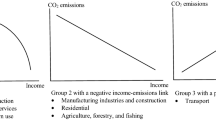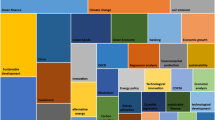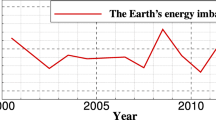Abstract
China is planning to introduce carbon tax policy to control the carbon emissions of the country better and achieve the “3060 goals”, but there is still widespread discussion about how to introduce it and how to combine it with cap and trade. China has already established a national carbon emission trading market; however, there is also disagreement on whether to impose the carbon tax on companies and projects that have been included in scope of cap and trade. This paper adopts the research method of experimental economics to study the effect on social economy and social emission reduction under cap and trade, carbon tax, and carbon tax-carbon trading policies, and analyzes average prices of carbon market under cap and trade and carbon tax-carbon trading policies. The study finds that under the carbon tax-carbon trading policy, carbon emissions cannot be reduced significantly; but the profits of manufacturers will be reduced significantly; meanwhile, this reduction effect is even more severe for high consumption manufacturers; and it will be resulting in a lower average carbon market price under the carbon tax-carbon trading policies than under the cap and trade policy. This paper will provide theoretical suggestions for introducing carbon tax policy into China in the future and make policy recommendations for the better development of China’s carbon market.








Similar content being viewed by others
Data availability
The authors declare that the data related to the experiments in this paper are available to the journal or to the readers upon request.
Notes
• https://openknowledge.worldbank.org/bitstream/handle/10986/35620/211728CH.pdf?sequence=14&isAllowed=y Data on carbon tax rates for selected countries in 2021 are from Word Bank.
References
Benjaafar S, Li Y, Daskin M (2013) Carbon footprint and the management of supply chains: insights from simple models. IEEE Trans Autom Sci Eng 10(1):99–116
Cao J, Ho MS, Jorgenson DW, Nielsen CP (2019) China’s emissions trading system and an ETS-carbon tax hybrid. Energy Econ 81:741–753
Cao K, He P, Liu Z (2020) Production and pricing decisions in a dual-channel supply chain under remanufacturing subsidy policy and carbon tax policy. J Oper Res Soc 71(8):1199–1215
Chen Y-H, Wang C, Nie P-Y, Chen Z-R (2020) A clean innovation comparison between carbon tax and cap-and-trade system. Energ Strat Rev 29:100483
Drake DF, Kleindorfer PR, Van Wassenhove LN (2016) Technology choice and capacity portfolios under emissions regulation. Prod Oper Manag 25(6):1006–1025
Edziah BK, Sun H, Adom PK, Wang F, Agyemang AO (2022) The role of exogenous technological factors and renewable energy incarbon dioxide emission reduction in Sub-Saharan Africa. Renew Energy 196:1418–1428
Feng S, Howes S, Liu Y, Zhang K, Yang J (2018) Towards a national ETS in China: cap-setting and model mechanisms. Energy Econ 73:43–52
Fischbacher U (2007) z-Tree: Zurich toolbox for ready-made economic experiments. Exp Econ 10:171–178 (Fischbacher,Urs/0000-0002-5115-8815)
Greenstone M, Gayer T (2009) Quasi-experimental and experimental approaches to environmental economics. J Environ Econ Manag 57(1):21–44
Haites E (2018) Carbon taxes and greenhouse gas emissions trading systems: what have we learned? Climate Policy 18(8):955–966
He P, Zhang W, Xu X, Bian Y (2015) Production lot-sizing and carbon emissions under cap-and-trade and carbon tax regulations. J Clean Prod 103:241–248
Holt CA, Shobe WM (2016) Reprint of: Price and quantity collars for stabilizing emission allowance prices: Laboratory experiments on the EU ETS market stability reserve. J Environ Econ Manag 80:69–86
Hu Y-J, Li X-Y, Tang B-J (2017) Assessing the operational performance and maturity of the carbon trading pilot program: the case study of Bei**g’s carbon market. J Clean Prod 161:1263–1274
Huang J, Xue Y, Jiang C, Wen F, Xue F, Meng K, Dong ZY (2015) An experimental study on emission trading behaviors of generation companies. IEEE Trans Power Syst 30(2):1076–1083
Jia Z, Lin B (2020) Rethinking the choice of carbon tax and carbon trading in China. Technol Forecast Soc Chang 159:120–187
Jiang M, Feng X, Li L (2021) Market power, intertemporal permits trading, and economic efficiency. Front Energy Res 328
Jones LR, Vossler CA (2014) Experimental tests of water quality trading markets. J Environ Econ Manag 68(3):449–462
Li J, Fan J, Zhao D, Wang S (2015) Allowance price and distributional effects under a personal carbon trading scheme. J Clean Prod 103:319–329
Li Z, Liu P, Swallow SK (2022) The performance of multi-type environmental credit trading markets: Lab experiment evidence. J Environ Econ Manag 111:102563
Li L, Msaad H, Sun H, Tan MX, Lu Y, Lau AKW (2020) Green innovation and business sustainability: new evidence from energy intensive industry in China. Int J Environ Res Public Health 17(21)
Li L, Zhu B, Che X, Sun H, Tan M (2021) Examining effect of green transformational leadership and environmental regulation through emission reduction policy on energy-intensive industry's employee turnover intention in China. Sustainability 13(12)
Liu X, Wang C, Niu D, Suk S, Bao C (2015) An analysis of company choice preference to carbon tax policy in China. J Clean Prod 103:393–400
Mandell S (2008) Optimal mix of emissions taxes and cap-and-trade. J Environ Econ Manag 56(2):131–140
Mishra U, Wu J-Z, Sarkar B (2021) Optimum sustainable inventory management with backorder and deterioration under controllable carbon emissions. J Clean Prod 279:123699
Mohammed F, Selim SZ, Hassan A, Syed MN (2017) Multi-period planning of closed-loop supply chain with carbon policies under uncertainty. Transp Res Part D-Transp Environ 51:146–172
Murphy JJ, Stranlund JK (2006) Direct and market effects of enforcing emissions trading programs: an experimental analysis. J Econ Behav Organ 61(2):217–233
Ni J (2016) Study on Carbon Tax and Carbon Emission Trading Mechanism. Tax Research 04:46–50
Rogge KS, Hoffmann VH (2010) The impact of the EU ETS on the sectoral innovation system for power generation technologies - Findings for Germany. Energy Policy 38(12):7639–7652
Shen Y, Su Z-W, Malik MY, Umar M, Khan Z, Khan M (2021) Does green investment, financial development and natural resources rent limit carbon emissions? A provincial panel analysis of China. Sci Total Environ 755:142538
Smith S (2008) Environmentally related taxes and tradable permit systems in practice. Organisation for Economic Cooperation and Development, Environment Directorate, Centre For Tax Policy And Administration, Paris
Stranlund JK, Murphy JJ, Spraggon JM (2014) Price controls and banking in emissions trading: an experimental evaluation. J Environ Econ Manag 68(1):71–86
Sun H, Edziah BK, Sun C, Kporsu AK (2019) Institutional quality, green innovation and energy efficiency. Energy Policy 135:111002. https://doi.org/10.1016/j.enpol.2019.111002
Wei L-j,Peng Y,Liu X (2018) Stabilization Mechanisms in Carbon Markets: An Experimental Economics Study. China's Ind Econ (4) 174–92
Wei L-l, Ren L-y (2021) Can Carbon Emission Trading Promote Corporate Green Technology Innovation-Based on the Perspective of Carbon Price. Lanzhou J 07:91–110
Xu X, Xu X, He P (2016) Joint production and pricing decisions for multiple products with cap-and-trade and carbon tax regulations. J Clean Prod 112:4093–4106
Yang L, Li F, Zhang X (2016) Chinese companies’ awareness and perceptions of the Emissions Trading Scheme (ETS): evidence from a national survey in China. Energy Policy 98:254–265
Yenipazarli A (2016) Managing new and remanufactured products to mitigate environmental damage under emissions regulation. Eur J Oper Res 249(1):117–130
Zakeri A, Dehghanian F, Fahimnia B, Sarkis J (2015) Carbon pricing versus emissions trading: a supply chain planning perspective. Int J Prod Econ 164:197–205
Zhang Z, Zhang A, Wang D, Li A, Song H (2017) How to improve the performance of carbon tax in China? J Clean Prod 142:2060–2072
Zhang H, Duan M, Li D (2019) The impact of China’s pilot carbon emissions trading systems on low-carbon technology innovation: an empirical analysis of pilot-covered enterprises. J Environ Econ 4(2):10–27
Zhu Y (2022) Our carbon tax is not a tax for tax's sake. Chinese oil companies,28 March 2022, p37
Funding
This work was supported by “2022 Guangdong University Student Innovation and Entrepreneurship Training Program” (S202210559156) and “Special Funds for the Cultivation of Guangdong College Students’ Scientific and Technological Innovation. (“Climbing Program” Special Funds.)”(pdjh2023b0069).
Author information
Authors and Affiliations
Contributions
The author, Hanting Wang, was responsible for Ztree experimental programming, experimental data analysis, and paper writing. And the author Yuxuan Li was responsible for organizing the experiments, graphing, writing the introduction of the paper, and searching for relevant data. Author Bu Guoqin was responsible for the formulation of the thesis topic, the revision of this paper, and the guidance of the thesis writing.
Corresponding author
Ethics declarations
Ethical approval
The authors declare that all subjects who participated in the experiment were informed and volunteered to participate in the experiment and were eventually paid for the experiment, which was approved by the Dean of International Business School of **an University. The ethical and moral issues related to this experiment are not related to the journal, and the authors and their organization assume the ethical and moral responsibility.
Consent to participate
Not applicable.
Consent for publication
The authors declare that all authors of this article have given their knowledge and consent to the publication of the paper.
Competing interests
The authors declare no competing interests.
Additional information
Responsible Editor: Roula Inglesi-Lotz
Publisher's note
Springer Nature remains neutral with regard to jurisdictional claims in published maps and institutional affiliations.
The 3060 goals refer to the Chinese government’s proposal that China will strive to achieve its carbon peak by 2030 and its carbon neutrality by 2060.
In this paper, cap-and-trade and carbon trading are the same policy, and they both represent the policy of trading carbon allowances in the carbon market for emission-controlled enterprises under government carbon quota control. Two representations are used in this paper to avoid ambiguity in expressing compound policies.
Appendix
Appendix
The following figure shows a carbon trading market scenario simulated by Ztree software (Since the subjects were all Chinese, the software interface language settings were all in Chinese):

The following figure shows the production decision screen simulated by Ztree software (since the subjects were all Chinese, the software interface language settings were all in Chinese).

Rights and permissions
Springer Nature or its licensor (e.g. a society or other partner) holds exclusive rights to this article under a publishing agreement with the author(s) or other rightsholder(s); author self-archiving of the accepted manuscript version of this article is solely governed by the terms of such publishing agreement and applicable law.
About this article
Cite this article
Wang, H., Li, Y. & Bu, G. How carbon trading policy should be integrated with carbon tax policy—laboratory evidence from a model of the current state of carbon pricing policy in China. Environ Sci Pollut Res 30, 23851–23869 (2023). https://doi.org/10.1007/s11356-022-23787-y
Received:
Accepted:
Published:
Issue Date:
DOI: https://doi.org/10.1007/s11356-022-23787-y




